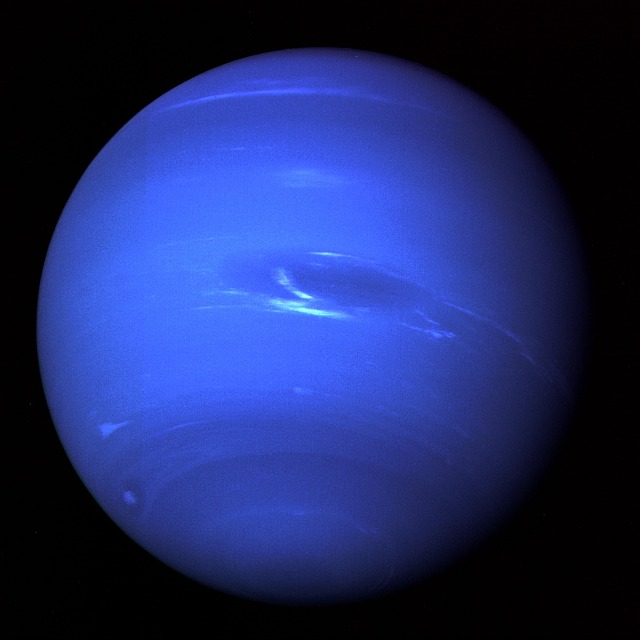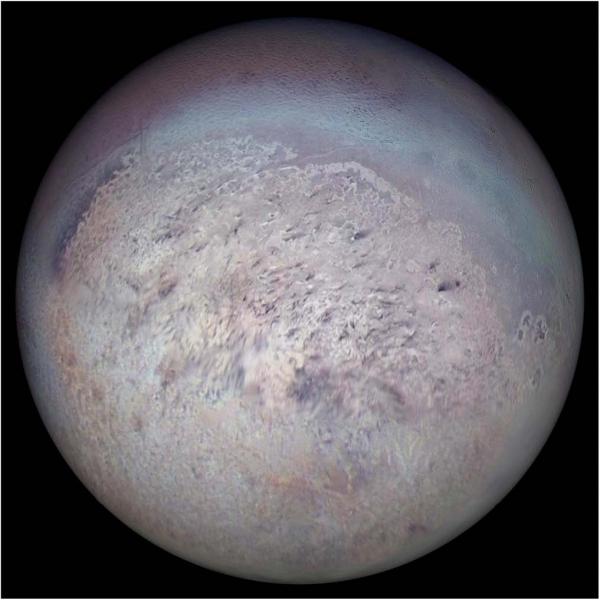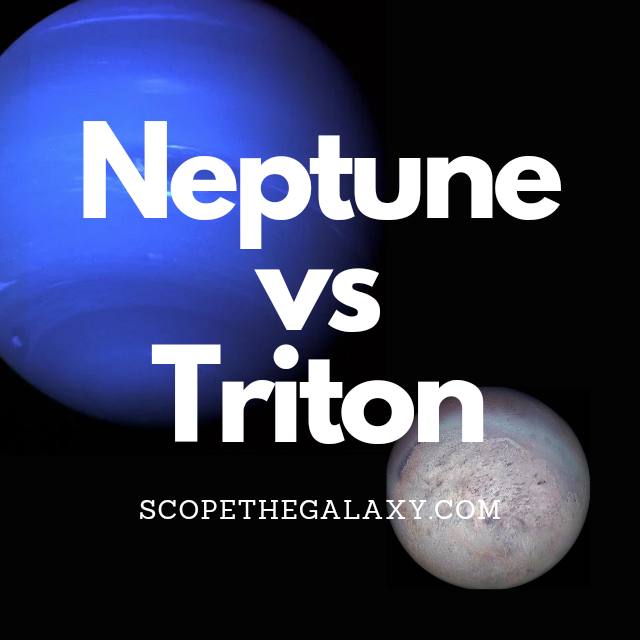*This post may contain affiliate links. This means we may make a commission if you purchase an item using one of our links*
Although Neptune and Triton are related in the sense that Triton is Neptune’s largest moon, there differ more than they are similar.
The main differences between Neptune and Triton are that Neptune is an ice based gas giant whilst Triton is terrestrial based natural satellite, Neptune is far bigger with a diameter of 49,244km whereas Triton’s is 2,706km and Neptune has 14 moons orbiting it whilst Triton has 0.
There are number of other differences between the two so, continue reading for a more detailed look at each celestial body along with their similarities and differences below.
What Is The Moon Neptune?
Table of Contents

Neptune is the 8th farthest planet from the Sun and ranks among the bigger planets in our solar system. As the 8th farthest planet from the Sun, it does take Neptune a very long time to complete 1 orbital around the Sun.
This takes 165 years to complete which in comparison to the 16 hour 1 full spin around the axis is a massive difference.
In regards to its composition, Neptune is mostly made up of a thick swath of water closer to the center, methane, ammonia, hydrogen and helium molded around its Earth sized core.
As a result of the excess amount of methane and the inclusion of another undiscovered element within the atmosphere, Neptune’s color is a far deeper blue than the likes Uranus, which also has an abundantly methane based atmosphere.
The planet is 49,244km in diameter, making it roughly 4 times Earth’s diameter Earth, and would allow around 57 Earths to fit inside it. This also makes Neptune the 4th largest planet in our solar system.
Neptune is very cold mostly down to its distance from the Sun, where its atmospheric temperature sits between -220 to -230 degrees Celsius. Its core is far hotter coming in at 5,100 degrees Celsius and is the very likely cause for the liquid water present within the planet
Subsequently, the erratic temperature and gaseous composition of Neptune, is what constitute towards its turbulent behavior.
In fact Neptune has the fasted winds in our solar system, producing some that eclipse speeds of 2,000km per hour. The fastest winds on Earth would only be a fifth of these speeds at most.
At this moment in time we have discovered 14 moons orbiting Neptune and have also observed 5 thinner rings surrounding the ice giant.
What Is The Moon Triton?

Triton is the largest moon of Neptune, whose most unusual feature is its retrograde orbit. Triton is the only major moon in our solar system which orbits in the opposite direction of its planet’s rotation.
First discovered on 10th October 1846 (just 17 days after the discovery of its planet, Neptune) by British astronomer William Lassell, “Triton” comes from a merman in Greek myth; a name which perhaps stems from the composition of this faraway moon.
The diameter of Triton is approximately 2,706km, making it a similar size to Earth’s moon. However, we know that its mass is far less than the first estimates suggested because data from Voyager showed that the surface is icy and highly reflective, a less dense composition than the dark surface of our moon.
This icy surface has resulted in ice based natural satellite displaying temperatures in the region of – 235 degrees Celsius.
This lower density stems predominantly from the water-ice interior encasing a denser rock core. Still, the mean density of 2.06 grams per cubic cm remains higher than that of any of Saturn’s or Uranus’ moons. In addition, Triton holds more than 99.5% of the mass of everything that orbits the planet Neptune and its total mass is greater than every smaller satellite in the solar system combined.
Scientists think that Triton may be an object from the Kuiper Belt that Neptune’s gravity captured millions of years ago. This is because it shares many similarities with the dwarf planet Pluto – the best-known world within the Kuiper Belt.
This frozen world is a land of geological oddities with craters and a collection of depressions and ridges known as cantaloupe terrain. The geysers found on this moon shoot plumes of nitrogen as high as 8km high, which creates a thin atmosphere of nitrogen.
In around 3.5 billion years, Triton’s orbit will travel too close to Neptune, and the planet’s gravitational pull will break the moon apart, creating a ring system.
Similarities Between Neptune And Triton
There are a few similarities that Neptune and Triton share, which in this case includes the following:
- Both are a spherical shape.
- Both have a hotter core.
- Both are part of the same solar system.
- Neither have tectonic plates.
- Both orbit another object.
- Both orbit the Sun in 165 years.
Differences Between Neptune And Triton
The differences between the two include the following:
- Triton orbits Neptune whilst Neptune only orbits the Sun.
- Neptune is an ice based gas giant whilst Triton is a terrestrial based natural satellite.
- Neptune has 14 moons whilst Triton has 0.
- Neptune has a diameter of 49,244km whilst Triton’s diameter is 2,706km.
- Triton has a very thin exosphere composed mostly of nitrogen with small amounts of methane whilst Neptune is gas based, composed mostly of hydrogen with smaller amounts of methane and helium.
- A day on Triton takes 5.877 days whilst a Neptune day takes 16 hours.
- It takes Triton 5.877 days to orbit Neptune and around the Sun in 165 years whilst Neptune orbits the Sun in 165 years.
- Neptune has an axial tilt of 28 degrees whilst Triton’s axial tilt is close to 0.
- Triton’s average temperature is around -235 degrees Celsius whilst Neptune has an average temperature of -220 to – 230 degrees Celsius.
- Neptune’s density is 1.64 g/cm³ whilst Triton’s density is 2.06 g/cm³.
- Neptune’s mass is 1.024 × 10^26 kg whilst Triton’s mass is 2.14 × 10^22 kg.
- Triton’s gravitational strength is 0.779 m/s² whilst Neptune’s is 11.15 m/s².
- Triton is the only moon in our solar system that orbits its planet in a retrograde orbit whilst Neptune orbits the Sun.
- Triton is tidally locked to Neptune whilst Neptune is not tidally locked to any entity.
- Neptune has a magnetosphere whilst Triton does not.
Summary
Although these two share a few similarities such as the fact both take 165 years to orbit the Sun and are part of the same solar system,
However, whether it be in regards to their differences in mass, size, length of day, the number of bodies that orbit them, their physical composition and more, Neptune and Triton are designed to function completely distinctly from one another.


